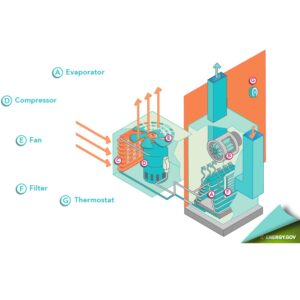How Air Conditioning Works: A Simple Homeowner’s Guide
When the heat is on, nothing feels better than stepping into a cool, comfortable home. But have you ever wondered exactly how air conditioning works? Most homes, especially here in South Florida, rely on ducted AC systems to keep the indoor environment pleasant.
This post will break down the process in simple terms so you can understand what’s happening behind the scenes, ensuring your comfort even during the hottest days.
The Main Components of Your AC System
Let’s start by looking at the two main parts of your ducted air conditioning system:
The Condensing Unit (Outside)
The condensing unit, usually located outside your home, plays a critical role in releasing heat absorbed from inside your house. It works by cooling the refrigerant, which is responsible for absorbing and transferring heat.
When the refrigerant reaches the condensing unit, it’s cooled down, allowing it to continue the cycle and help maintain a comfortable indoor temperature.
The Air Handler (Inside)
Inside your home, typically tucked away in a closet, you’ll find the air handler. This unit circulates the cooled air throughout your home. It also houses the evaporator coil, where warm air from your house is cooled before being pushed back into your living spaces.
Additionally, the air handler contains a filter that helps keep your indoor air clean by trapping dust and other particles.
How Does the Cooling Process Work?
1. Absorbing Heat from Your Home
Your AC system starts by pulling warm air from inside your house. This air is drawn into the air handler and passes over the evaporator coil, where the refrigerant absorbs the heat.
2. Removing Humidity
During the cooling process, your AC doesn’t just lower the temperature. It also helps reduce humidity. As the warm air passes over the evaporator coil, moisture from the air condenses on the coil and is drained out of your home.
This is especially important in humid climates like South Florida, as lower humidity levels make the air feel cooler and more comfortable.
3. Transferring Heat to the Outside
Once the refrigerant absorbs the heat, it travels to the condensing unit outside, where the heat is released into the air. The outdoor unit’s fan helps to disperse the heat, allowing the refrigerant to cool down and restart the cycle.
4. Circulating Cool Air Back into Your Home
After the heat is released outside, the refrigerant returns to the evaporator coil, where it cools the air inside your home. This cool air is then distributed throughout your house via ductwork, ensuring every room stays comfortable.
Why Ductwork Matters for Cooling?
Ductwork acts like a network of highways, transporting cooled air from the air handler to each room in your home. If the ducts are well-maintained and properly sealed, your home will cool evenly. However, leaks or damage in the ductwork can lead to uneven cooling and wasted energy.
Keeping your duct system in good shape is just as important as maintaining the AC unit itself.
How the Thermostat Controls the System
Your thermostat is the control center of your AC system. It senses the temperature in your home and signals the air conditioner to turn on or off based on the settings you’ve chosen. But beyond just controlling temperature, some modern thermostats also allow you to adjust humidity levels, giving you greater control over your home’s comfort.
Set your thermostat to a comfortable temperature, and the AC will handle the rest by turning on when it gets too warm and shutting off once the desired temperature is reached. This not only keeps you comfortable but also helps save energy.
The Importance of Regular Maintenance
Now that you understand how air conditioning works, it’s important to know how to keep your system in top condition. Regular maintenance is key to ensuring your AC runs efficiently. Tasks like replacing the air filter, cleaning the evaporator and condenser coils, and checking refrigerant levels can prevent costly repairs and improve your system’s performance.
Scheduling professional AC tune-ups at least once a year ensures that any minor issues are addressed before they become bigger problems.
Stay Cool and Comfortable All Year Long
Understanding how air conditioning works can help you appreciate the system that keeps you comfortable day in and day out. From absorbing heat inside your home to releasing it outside and distributing cool air through your ductwork, each part of the process is essential for keeping your home cool.
Don’t forget regular maintenance is the best way to ensure your AC runs efficiently and avoids unnecessary breakdowns. If you have any questions or want to schedule a professional tune-up, feel free to contact us. We’re here to help you keep your home comfortable year-round.
If you found this article helpful, please share it with someone who might benefit from learning more about how their air conditioning works. You can also watch this instructive video. We’d also love to hear your thoughts. Leave a comment below!

